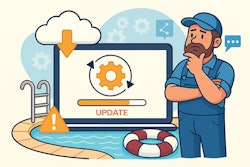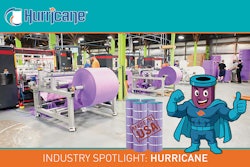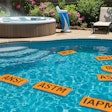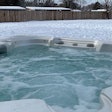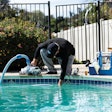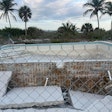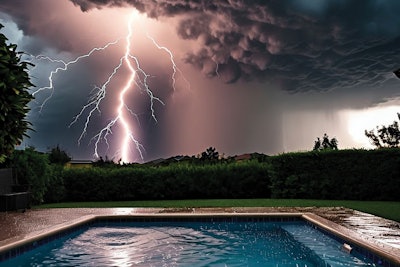
Twenty five years ago, most pool equipment came with a simple on/off switch; maybe the single-speed pump featured mechanical timeclock “automation,” but that’s about it. Pool equipment today has lots of automation and embedded electronics, which give it intelligence and connectivity with other components and the owner’s smartphone. These electronics, however, make modern pool pumps and heaters far more vulnerable to electrical surges than their predecessors.
“Everything is connected now, which means the equipment and the components have integrated electronics and software,” says Brian Lamberty, pool industry equipment veteran. Lamberty is product manager for Intermatic’s pool and spa electrical category. In his 34-year career, Lamberty has seen the growing importance of surge protection throughout the entire home equipment industry, culminating in a milestone change in the NEC (National Electrical Code) guidelines in 2020 that now mandate all dwellings be provided with a surge protective device (SPD).
Side note: Most readers will think of surge protection as something contained in a power strip where you plug in your computer. But the sort of surge protection being discussed in this article is installed at the home electrical panel or the backyard subpanel.
“We’ve seen it on the residential side with the NEC codes for new installation and replacement in all living spaces, homes, apartments, guest rooms, suites and hotels, nursing homes, limited care facilities, stuff like that. The code recognizes the growing need for surge protection to help safeguard mission-critical electronic equipment — that is, to minimize the damage and downtime that electrical surges create.”
In short, Lamberty says, the NEC has recognized that modern home appliances contain vulnerable circuitry, but in reality, that vulnerability extends to the pool area where expensive equipment is also at risk.
 Circuitry and motherboard for an Intermatic ECO series heat pump which uses inverter technology, displaying to the naked eye the high level of electronic sophistication in modern pool equipment.
Circuitry and motherboard for an Intermatic ECO series heat pump which uses inverter technology, displaying to the naked eye the high level of electronic sophistication in modern pool equipment.
INVENTORY OF PRICEY PIECES
There is indeed a lot of electronic equipment in the modern poolscape. LED lighting now includes electronics and software for color-changing patterns and synchronization capabilities. Pool automation modules contain extensive electronics, as do pool heaters, heat pumps, variable-speed pumps, water quality monitors and chlorine generators, even plug-in robotic pool cleaners — they all have electronic controls and software.
“There was already a lot of sophisticated pool equipment in the backyard,” Lamberty says, “but the new, inverter technology in pool heat pumps takes it to another level. The COP efficiency ratings with inverter water-sourced Heat Pump technology can double the COP ratings of older On/Off technology, but at the same time, it needs surge protection. If you look inside one of those condensing units, it honestly resembles the insides of a computer more than it does a traditional condensing unit. The inverter technology, while a big improvement
in efficiency, is susceptible to transient damage that could be created by voltage surges — we learned that on the HVAC side.
“That’s the challenge to the pool industry — to protect this equipment from electrical surge. And it’s not just the pool equipment, but also the wire and conduits around the pool, which must also be dug up and replaced when damaged by the significant voltage trauma related to surges.”
LITTLE SPIKES
Most people think electrical surge comes from a storm, and it’s true that lightning strikes can induce massive voltage spikes that destroy equipment and fry wiring instantly. Storms also damage power lines, leading to sharp destructive surges when power is restored.
However, smaller, more frequent surges due to simple switching can cause damage that eventually leads to the same result — a piece of equipment rendered useless before its time.
When a high-powered electrical appliance, such as a 2-horsepower pump turns on or off, a smaller power spike can occur because the sudden large power demand or drop disturbs the steady voltage flow throughout the electrical system. This can cause damage to other electronics on the circuit.
These smaller, much more frequent surges can cause unseen damage in tiny increments that accumulate over time. They may not disable an appliance in one shot, but they can shave years off the functional life of any device. Lamberty says SPDs offer protection from both types of power spikes.
THE BUSINESS SIDE
For a pool service company, the point of surge protection is obvious. It prevents early equipment failure due to damaging spikes in electrical current. But how can it be integrated into service company offerings?
Is it better to install as part of the service package to help avoid pool downtime and lessen the burden of warranty claims that you, as a provider, will have to process? Downtime is undoubtedly a big issue, and the sudden loss of a pool pump may mean weeks of it in the heart of the season.
“You can get the equipment replaced when it’s damaged, but do the homeowners and users really want that downtime? Do they really want weeks to go by where they can’t use their pool?” says Lamberty. “Losing two weeks of the [short, Midwestern] pool season is significant here.
“On the other hand, it’s a quick upsell and a quick installation [about 20 minutes] that provides insurance against downtime and protects your high-cost investments. like an $8,000 heater. Because mainly, customers don’t want the expense required to have something replaced or repaired, and even if it’s on a warranty, they don’t want the downtime.”
This article first appeared in the July 2025 issue of AQUA Magazine — the top resource for retailers, builders and service pros in the pool and spa industry. Subscriptions to the print magazine are free to all industry professionals. Click here to subscribe.


























